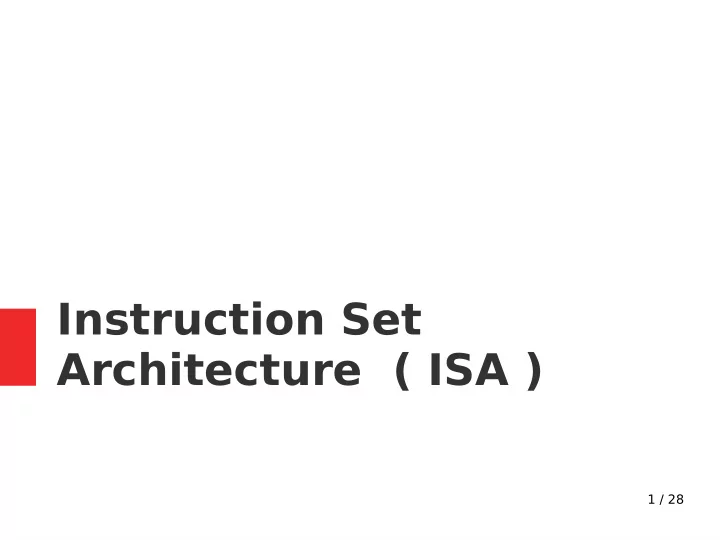

Instruction Set Architecture ( ISA ) 1 / 28
instructions 2 / 28
Instruction Set Architecture ● Also called (computer) architecture ● Implementation --> actual realisation of ISA ● ISA can have multiple implementations ● ISA allows software to direct hardware ● ISA defnes machine language 3 / 28
ISA model 4 / 28
ISA defnes... ● Data types ● Memory (registers et. al.) ● Addressing modes ● Instruction set ● I/O 5 / 28
What is an ISA? ● x86 --> yes! – Intel implements x86 – AMD implements x86 – Yet, both have diferent designs!!! ● Therefore, processors with diferent designs (microarchitectures) can share the same ISA 6 / 28
Virtual Machines ● Java Bytecode, anyone??? – Java programs are compiled to instruction set specifc to the Java VM – Java VM translates bytecode to machine specifc machine code ● Possible to implement one ISA one top of another one using such techniques 7 / 28
How to classify ISA? ● Based on complexity – Complex Instruction Set Computer (CISC) – Reduced Instruction Set Computer (RISC) ● Parallelism / Word size – VLIW (very long instruction word) – LIW (long instruction word) – EPIC (explicitly parallalel instruction computing) 8 / 28
CISC ( complex ) ● Single instruction can execute multiple operations (low level --> I/O, ALU, mem) ● CISC was defned after RISC was defned – But CISC came before RISC ( bizzaro! ) – Everything that is not RISC... is CISC 9 / 28
CISC ( complex ) Designed to implement programming constructs such as: – Proceduce calls – Loops – Array access – Address lookups ... into a single instruction!!! 10 / 28
CISC ( complex ) CISC is awesome..... But... There’s a catch... Sometimes less complex instructions performed better... Because programmers ‘overengineered’ ( typical! ) 11 / 28
CISC and the return of the Superscalar ● Build superscalar implementations of CISC directly (native support) ● Advances in fast cache mediate frequent memory accesses ● Combine x86 instructions ● E.g. Pentium Pro and AMD K5 ● Why didn’t it catch on??? ... because everyone was using x86 RISC by then 12 / 28
Why did we take RISC? ● Reduced, as in, less complex than CISC ● Requires lesser cycles to execute ● Loose defnition of instructions – simpler and smaller and general ● Has more (reduced set? no?) instructions 13 / 28
Stanford MIPS Experiment ● Combine RISC with VLSI (very large scale integration semiconductor technology) ● 32-bit everything – instruction, addressing (word-addressed) ● Load/Store – 32 general purpose registers ● Optimising compilers!!! 14 / 28
RISC ● Fixed-length instructions (mostly 32bit) ● Drawback? Code density. ● ARM, MIPS, RISC-V – short reduced instruction – instruction compression ● ARM... is the processor in your phones! You’re all carrying a RISC in your pockets! 15 / 28
What architecture is my desktop/laptop CPU? RISC? CISC? 16 / 28
What architecture is my desktop/laptop CPU? It implements the best of both worlds!!! 17 / 28
Levels of parallelism ● Thread ● T ask ● Data ● Memory ● Software 18 / 28
MPP Massively Parallel Processing ● Large number of processors ● Simultaneously process ● Can be diferent computers ● e.g. Grid computing ● MPPAs – massively parallel processing arrays ● Used in supercomputers (this is not cluster computing) 19 / 28
Grid Computing ● Distributed system ● Non-interactive workloads ● Each node (can) perform a diferent task ● Nodes can be heterogenous ● Nodes are not physically coupled 20 / 28
GPU / GPGPU ● General Purpose computing on Graphical Processing Unit (GPGPU) ● Use GPU instead of CPU ● GPU is great at parallelisation ● Use multiple GPUs in a pipeline formation ● e.g. Nvidia CUDA ● e.g. Metal (Apple), Vulkan ● More later!!! (really later, in like, another lecture) 21 / 28
Vector Processor ● Instructions operate on vectors (1D) --> SIMD !!! ● Scalar processors operate on one item ● Awesome for numerical tasks ● GPUs are kind of like vector processors ● Intel x86 – MMX, SSE, AVX ● We’ll learn about SSE soon. 22 / 28
Gustafson’s & Amdahl’s Law ● A task executed by a system whose resources are improved compared to an initial similar system can be split into two parts: – a part that does not beneft from the improvement of the resources of the system; – a part that benefts from the improvement of the resources of the system. 23 / 28
Gustafson’s Law fxed execution time 24 / 28
Amdahl’s Law fxed workload 25 / 28
Parallel Programming Languages ● Actor model: Smalltalk, Erlang, Elixir ● Co-ordination: LINDA ● Datafow: Joule ● Distributed: Julia ● Event-driven: Verilog, VHDL ● Functional: Haskell ● Logic: Prolog 26 / 28
Parallel Programming Languages ● Multi-threaded: C, C++, Java ● Object-oriented: C#, Java, Smalltalk ● Message passing: Rust ● Frameworks – Apache Hadoop, Apache Spark, CUDA, – OpenCL, OpenMP 27 / 28
Let’s discuss the assignment!!! The assignment is simple . Implement 1 searching algorithm and 1 sorting algorithm in non-parallel and parallel execution formats, and compare them. Write a report on your findings. Submission date: FRIDAY 23:59 16 March 2018 UTC. How to submit: blackboard, upload as many times as you want 28 / 28
Recommend
More recommend